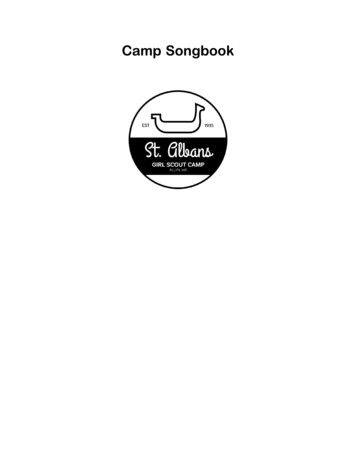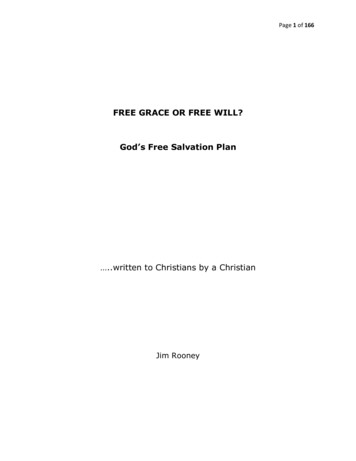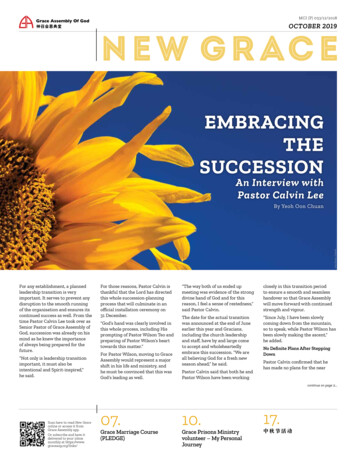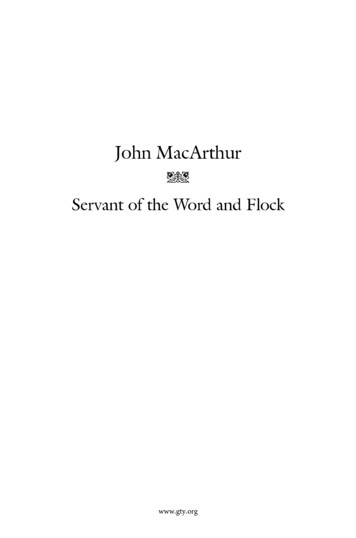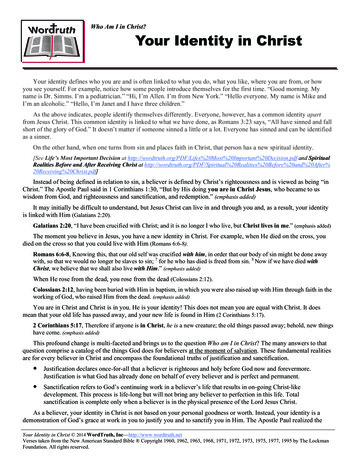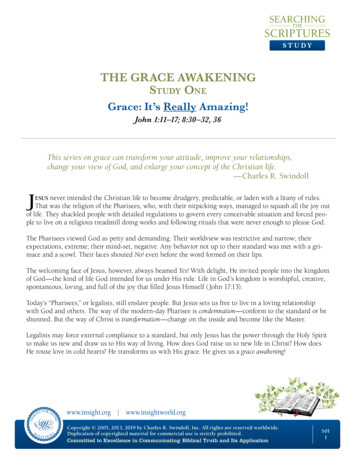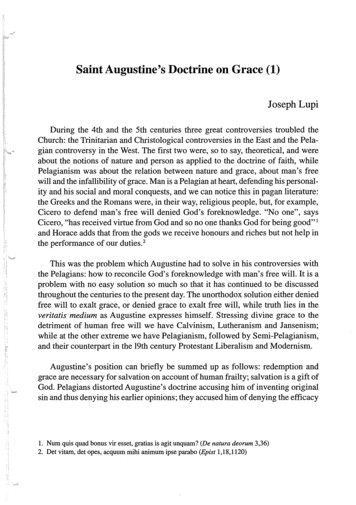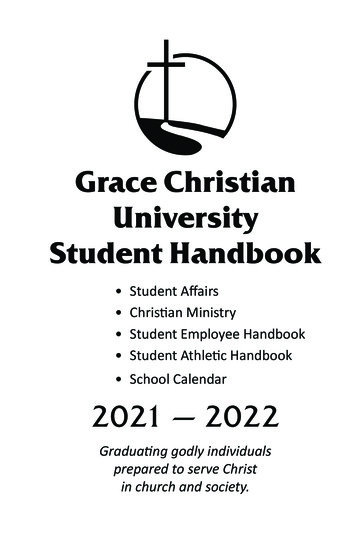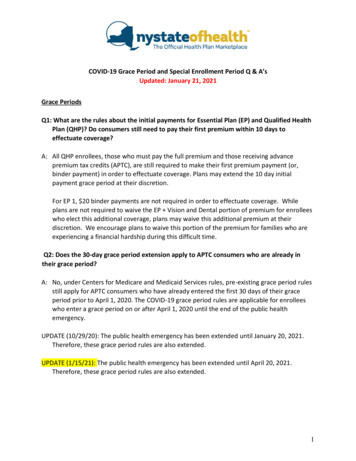
Transcription
COVID-19 Grace Period and Special Enrollment Period Q & A’sUpdated: January 21, 2021Grace PeriodsQ1: What are the rules about the initial payments for Essential Plan (EP) and Qualified HealthPlan (QHP)? Do consumers still need to pay their first premium within 10 days toeffectuate coverage?A: All QHP enrollees, those who must pay the full premium and those receiving advancepremium tax credits (APTC), are still required to make their first premium payment (or,binder payment) in order to effectuate coverage. Plans may extend the 10 day initialpayment grace period at their discretion.For EP 1, 20 binder payments are not required in order to effectuate coverage. Whileplans are not required to waive the EP Vision and Dental portion of premium for enrolleeswho elect this additional coverage, plans may waive this additional premium at theirdiscretion. We encourage plans to waive this portion of the premium for families who areexperiencing a financial hardship during this difficult time.Q2: Does the 30-day grace period extension apply to APTC consumers who are already intheir grace period?A: No, under Centers for Medicare and Medicaid Services rules, pre-existing grace period rulesstill apply for APTC consumers who have already entered the first 30 days of their graceperiod prior to April 1, 2020. The COVID-19 grace period rules are applicable for enrolleeswho enter a grace period on or after April 1, 2020 until the end of the public healthemergency.UPDATE (10/29/20): The public health emergency has been extended until January 20, 2021.Therefore, these grace period rules are also extended.UPDATE (1/15/21): The public health emergency has been extended until April 20, 2021.Therefore, these grace period rules are also extended.1
Q3: Should plans be terminating EP consumers who did not pay their March 2020 premium?A: At this time, plans should refrain from disenrolling consumers who fail to pay their 20 EP 1premium contribution. While plans are not required to provide an extended grace period toEP Vision and Dental enrollees for the Vision Dental portion of the premium, plans mayextend a grace period at their discretion. We encourage plans to make this grace periodavailable to families who are experiencing a financial hardship during this difficult time.Q4: Per NY State of Health guidance, plans will delay the QHP-APTC grace period for anadditional month resulting in a 120-day grace period. After 120-days, if the full premiumamount is ultimately unsatisfied by the end of the 120-day grace period, then from what dateshould the plan process the termination?A: If an enrollee does not satisfy their premium by the end of the 120-day grace period, theircoverage should be terminated as of the 60th day of their grace period. The terminationwould be sent to NYSOH with an end date equivalent to the end of the second month of the120-day grace period. Plans will cover claims for the first 60 days of the grace period, andper CMS guidance, plans will receive APTC for this 60-day period (2 months of APTC).For example, under current rules, an existing enrollee’s premium payment for the month ofApril 2020 is due by April 1, which would be the start of the 90-day grace period. Under theemergency federal rules, the grace period runs through the end of July (120 days). If theindividual ultimately does not make their premium payment, the plan would send NYSOH atermination transaction at the end of July, with an end date of May 31. The plan wouldretain the APTC for the months of April and May.Q5: If a consumer is terminated for non-payment after the 120-day grace period, can theyreapply for QHP coverage in the same plan or another plan offered through NYSOH?A: Generally, no. Consumers who are terminated for non-payment after 120-days will not beable to re-enroll in a QHP until the beginning of Open Enrollment for plan year 2021 unlessthey have a qualifying life event triggering special enrollment, or unless the emergency SEPis extended. If the consumer has an income change and is eligible for Medicaid, EssentialPlan or Child Health Plus, they can update their application information and enroll in thecoverage for which they are eligible.2
Q6: Should plans continue to take payments from EP consumers if they do pay?A: Yes, plans should continue to invoice consumers for their premium contribution on amonthly basis, but if the payment is not received, the consumer should not be disenrolled.Q7: Who is responsible to pay claims for services during the 120-day grace period for QHPconsumers with APTC?A: Per CMS guidance, plans are responsible for paying claims for the first 60-days of the graceperiod; plans may pend claims for days 61-120 of the grace period. If a consumer issubsequently terminated for non-payment after 120-days, the plan is not responsible forpayment of claims incurred during day 61-120 of the grace period (i.e., incurred after thedate of termination). Plans should communicate this to consumers and providers.Q8: Is NY State of Health requiring proof of hardship to enable these extended grace periodsfor subsidized enrollees?A: (Updated on 4/20/20) No, NY State of Health is not requiring proof of COVID-19 hardshipfor the premium payment and grace period flexibilities for EP, CHP, QHP-APTC. DFS hasissued guidance for the full premium populations; attestation of COVID-19 hardship isrequired for this population.3
PLEASE NOTE: These Q&A’s focus on the subsidized populations enrolling through NY State ofHealth: CHPlus, Essential Plan, and subsidized Qualified Health Plans. DFS guidance on the fullpremium populations is available here.Q9: For our CHPlus members, if we already received a 3/31/20 term on the 834 file, will weget a new transaction?A: Yes. As we did for the Medicaid population, CHPlus 4/1 renewals were sent to the plans on4/5. These were sent as 4/1 new enrollments.Q10: Should we expect to NOT receive any terminations or cancels from you at all until afterthe COVID-19 emergency ends?A: Plans should not expect any terminations related to renewals during this period. However,plans will still get some termination transactions for terminations required under federalrules, including individuals aging out of coverage (e.g., at 19 from CHPlus, at 65 for EP),member requested termination, or if a member moves.UPDATE (10/29/20): For QHP only, annual renewals will occur on or around November 15. Dueto the eligibility extensions that have already occurred for Medicaid, EP and CHP, all of therenewals will be for QHP members.Q11: Are plans expected to effectuate coverage for all EP members pending initial premiumfor 4/1 and forward?A: For EP 1 standard ( 20), plans should effectuate coverage upon receipt of the newenrollment transaction.Please remember that sending the effectuation transaction back to the state is stillrequired in order to prompt payments from eMedNY.Q12: Will plans be paid for any EP 1, EP 1 Vision and Dental, EP 2 Vision and Dentalmember that they effectuate without member payment?A: Yes, plans will still be paid the non-member responsibility portion of the premium.4
Q13: Should plans reinstate EP 1 enrollees who were termed March 1?A: The COVID-19 emergency grace period rules are effective April 1, 2020. Plans are notrequired to reinstate coverage for EP 1 enrollees who were termed for non-payment priorto April 1.Q14: Can we carry the premium balance forward for all programs (EP, CHP, QHP-APTC)?A: Yes, plans may carry premium balances forward for QHP-APTC, EP and CHPlus. Refer to DFSguidance for the full premium population. Additional guidance on EP and CHPlus premiumsdue may be provided at a later date.Q15: With regard to the QHP-APTC payment period extension, can NYSOH please confirmif/how this impacts the premium due date?A: There are no changes required to plan premium invoices or due dates.Q16: Which of the emergency grace period rules apply to Dental Plans?A: The COVID-19 emergency grace period rules do not apply to the dental portion ofpremiums. This refers to both Stand Alone Dental Plans and the dental and vision portionof the premium for EP 1 Vison and Dental and EP 2 Vison and Dental. However, wehighly encourage plans to make this grace period available for families who areexperiencing a financial hardship during this difficult time.5
Repayment of Premium Balances Post COVID-19 Grace PeriodQ17: Does NY State of Health have guidance for insurers concerning the repayment ofpremium balances from QHP APTC enrollees at the end of the 120-day COVID-19 graceperiod?A: Insurers may collect outstanding premium balances in full at the end of the 120-day graceperiod or, at the insurer’s discretion, they may enter into an alternative premium paymentarrangement with the member, which should be documented and shared with the member.This can include allowing members to pay missed premiums in installments, within thefollowing parameters:1. Retro-active termination of coverage cannot exceed 60 days.2. The rules must be consistently applied to all members.This is consistent with CMS guidance to federally facilitated exchanges (see section 7.6) andDFS guidance for QHP enrollees who do not receive tax credits. Insurers are encouraged tomake every effort possible to work with members experiencing financial hardship to makeaccommodations for alternative payment arrangements or assist the member in findingnew coverage.Q18: Does NY State of Health have guidance for insurers concerning the repayment ofpremium balances from EP enrollees at the end of the applicable grace periods?A: Plans should continue the practice of not terminating members for non-payment of their EP1 20 monthly premium throughout the duration of the public health emergency. At the endof the public health emergency, plans will have the discretion to waive outstanding premiumbalances. Of note, the 2021-22 Executive Budget proposes to eliminate the EP1 20 monthlypremium effective June 1, 2021.6
COVID-19 Exceptional Circumstances Special Enrollment PeriodQ19: What will the coverage start dates be for the COVID-19 Exceptional CircumstancesSpecial Enrollment Period (SEP), that was extended through December 31, 2020?A: Similar to the rules that been applied during the COVID-19 Exceptional Circumstances SEP,consumers will have a choice of when to begin to coverage. They will be allowed to choosea start date, outlined below, depending on when they are granted the SEP. Consumers willneed to call customer service to request a coverage start date different from what’sgranted through the online application. Consumers who apply for coverage online afterNovember 1, 2020 will complete an application for 2021 and will be asked if they wantcoverage for 2020. If so, they will be prompted to call Customer Service to complete theenrollment for November and/or December 2020 coverage.When Enrollment under this SEP is Completed:Coverage Begins:By October 15, 2020Choice of coverage start date: October 1, OR November 1, 2020Between October 16 and November 15, 2020Choice of coverage start date: November 1, OR December 1, 2020Between November 16 and December 15, 2020Choice of coverage start date: December 1, OR January 1, 2021Between December 16 and December 31, 2020 January 1, 20217
COVID-19 Grace Period and Special Enrollment Period Q & A’sUpdated: January 21, 2021Q20: Will the 2021 Open Enrollment Period be extended beyond January 31?A: Yes. Governor Cuomo announced on January 21, an extension of the Open EnrollmentPeriod to March 31, 2021. Extending the Open Enrollment Period to March 31, 2021 helpsto align New York with the federal Public Health Emergency which was recently extended toApril 20, 2021.The full press release can be found here: ounces-open-enrollment8
period prior to April 1, 2020. The COVID-19 grace period rules are applicable for enrollees who enter a grace period on or after April 1, 2020 until the end of the public health emergency. UPDATE (10/29/20): The public health emergency has been extended until January 20, 2021. Therefore, these grace period rules are also extended.

